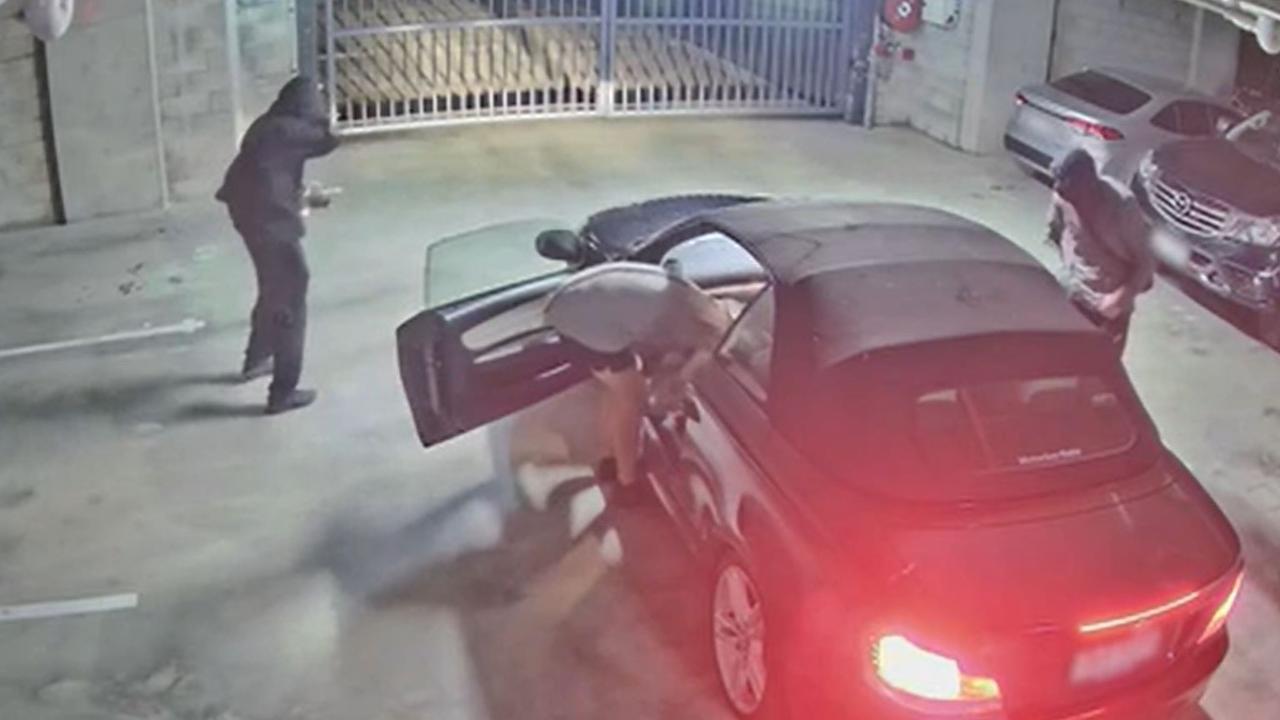Desperate mum sends plea to Qld Premier David Crisafulli
Queensland’s Premier has responded to a desperate mum who pleaded for out of control son to be locked up, as the state’s youth crime crisis is laid bare.

Police & Courts
Don't miss out on the headlines from Police & Courts. Followed categories will be added to My News.
Stacey knows her 14-year-old son will kill someone if confronted during a home invasion. Or perhaps he’ll kill himself, driving a stolen car at breakneck speed through the suburbs.
“I’ve told the judge in court. I’ve told the police, I’ve told everyone that it’s not going to end until he kills someone or he kills himself,” she said.
“And it might sound strange, but if he kills himself, I’ll be devastated. But if he becomes a quadriplegic or something like that, I swear to God, I don’t know how I’ll survive. It scares me.”
Stacey could be you or me, except her child is one of the teen offenders in daily headlines, breaking into homes, stealing cars, assaulting people and taking drugs like “ice”.
So far, he’s been lucky to escape death. He hasn’t been caught by a homeowner in the dead of night. But Stacey says he’ll take any weapon he can find, and use it against them.
She’s living on eggshells, not knowing where her son – let’s call him Tom – is, or what he will do next. As his mother, she’s told nothing. Not about the dozens of charges he’s faced, or his 10 or so court appearances, or how police found him with drugs, or the get-out-of-jail-free cards he keeps being handed.

“No one tells me what’s happening. I had no idea about the extent of some of the situations, which have been harrowing. Police told me he was caught with drugs and when I ask ‘what drugs’, they said they didn’t know,” she said.
Stacey has other children, but it’s only Tom she cannot control. She says despite what others might think, she’s always tried to be a good parent. Youth justice workers told her many families were in the same situation with one of their kids.
Discipline has always been valued in the family home. She’s taken Tom regularly to psychologists until he refused, and searched for programs that might stop the crime spiral that now seems out of control. Nothing has worked – especially the treatment meted out to her son at age 11, 12, 13 and now 14 in the courtroom.
“He gets off, gets off, gets off, gets off, and then the next time in court, he is given a 7pm to 7am curfew. So I’m ringing him at 10 (minutes) to 7pm saying, ‘Where are you?’ He’ll promise to return, and doesn’t.
“And then he goes back to court and nothing happens. Then he might get a 24-hour curfew until his next court date. But he’s out and about.
“What pisses me off the most is that every single time he goes to court, which is multiple times – over 10 – the judge says ‘this is what’s going to happen and if you do this again, this is what’s going to happen’, and every single time he gets off.”
What does she want to tell a judge determining her son’s punishment? “Don’t threaten stuff you are not going to do.”
Her son, she says, walks out of court each time knowing a bit more about playing the system, and what lines work.
“He keeps getting out and then commits the exact same crime. He’s building up (a long list) of these crimes. He should never have been allowed to practise what he’s been doing.”
Stacey says Tom will promise the judge he’ll take his ADHD medication, and that he is still enrolled at school. He’ll promise to attend rehabilitation programs and meet with youth workers – and then he’ll do none of it.
The court often didn’t have the information it needed to make decisions, either, Stacey says. At her son’s last appearance, prosecutors missed out a swag of charges involving the theft of seven cars. No one mentioned that a pre-sentence report had been done, either.
Her son routinely walks out of court and back to his friends, who are older, where the crime spree continues. And he’s learning on the job there, too. For example, stealing several cars means some can be used as decoys.
“He gets away with it. And every single time he gets out, he learns, ‘OK, so this is what happened, and this is what they think and say’.”
Tom has never been sentenced to a custodial sentence. He spent a week or so in custody on remand, and it was extended for various reasons, which added up to about a month. And even then, Stacey says, his time was spent playing cards and complaining about the food.
“We are turning them into criminals by not punishing them. It’s like parents not disciplining their kids – and it’s worse because they have the authority to do something.”
Stacey wants Premier David Crisafulli to know it’s not working now, and it won’t change with his “adult time for adult crime” plan. Given the chance, she’d explain that the problem is how it’s being handled by courts and that young criminals know they won’t be sent away for years.
“Every kid knows that’s a joke, right. I don’t like it either because when they go to court now, the judge might talk about adult time for adult crime – but it never happens.
“Judges won’t lock 10-year-olds away for 15 years, so it is setting everyone up for failure. And even if they did, it is ‘evil’ to lock a 12-year-old away for a decade or two. But what is happening now doesn’t work, either – allowing young criminals off repeatedly allows them to ‘get better’ at crime, and not cop the consequences of their actions.
“When you just keep letting them out, they get smarter and they figure out that they need to leave one car here, and one car here, and another here. They get better at what they do. How is that helping?”
Mr Crisafulli described Stacey’s story as “harrowing” and committed to continue to both strengthen laws as well as improve early intervention.
“To hear a mother’s cry for help, it shows you the result of a young child going off the rails in a system where there’s no consequences for actions for a long period of time,” Mr Crisafulli said.
“And I read her comments about there was nowhere to turn for those programs to turn that child around as well. So, look, some of the commentary in the early days of Adult Crime, Adult Time from the judiciary, and the sentences that have reflected that are heartening, but we’ve got a long way to go.”

Stacey says the Premier promised to fix it and needs to look at other options – providing programs for troubled children under the age of 14, ensuring prosecutors are aware of previous charges and sentencing reports, making judges follow through on any threats delivered in previous appearances, and taking those convicted out of the community for weeks, or months, not a few days on remand. She paints a picture of a system on a merry-go-round, just going through the motions.
“He’s got to do something. Even making sure the court has the right information. If they are taken in on Saturday and you don’t have all the information, why don’t they keep them in until they do?”
Tom’s siblings are embarrassed by his behaviour, and don’t want anything to do with him. Stacey has lost most of her friends. And she doesn’t know where to turn.
It wasn’t always like this. As a youngster, Stacey recalls taking Tom to the park every morning, in the hope it would wear him out, before dropping him at school. They’d cook and garden together. But he was always easily bored.
The fact Stacey and her husband are divorced and that Tom has ADHD are irrelevant, she says. “I don’t care whether someone has ADHD. You know right from wrong.”
She and her ex-husband had also tried to keep him out of trouble. Tom began by stealing his siblings’ birthday presents. His parents then noticed cash missing from the family home. At 10, he pushed someone over in the street, and ran off with a $5 note.
Stacey sought help, but ran into dead ends. Then before the end of primary school, Tom was suspended. He’d go out and arrive home with new clothes, and no explanation. “And it escalated from there,” Stacey said. “These older kids saw they could trust him. He’s not a snitch. He’s fast and he’s not scared. He’ll do whatever needs to be done.”
Tom would rarely abide by house rules. “I had rules like you can’t smash walls. You can’t abuse me. You need to be home before dark.” Cricket bats and golf clubs were removed from the home, and any weapon he used against a sibling was put in the garbage bin in front of him.
“He’s reactive, so if you piss him off, whatever’s right near him, he’ll pick up. I know my mum has been worried, but when he goes crazy, I don’t scream back at him. I don’t give him fuel.”
Expelled from two schools, by 13 he was skilled at breaking into homes and stealing cars. Just one court appearance involved several stolen cars, stolen fuel and food.
“There’s a group of them, and a lot of them are older. Honestly, it sickens me. It really sickens me.”
It’s a plea for help from a mother who is at her wit’s end.
She wants it to stop – for the sake of her family and her son and a community where many have locked themselves away, scared they might fall victim to a teen criminal, just like Tom.
Do you love him? Stacey doesn’t pause. “Of course, I love him, but I don’t like him a lot of the time.”
*Names have been changed to protect identities.
Read related topics:Youth Crime




